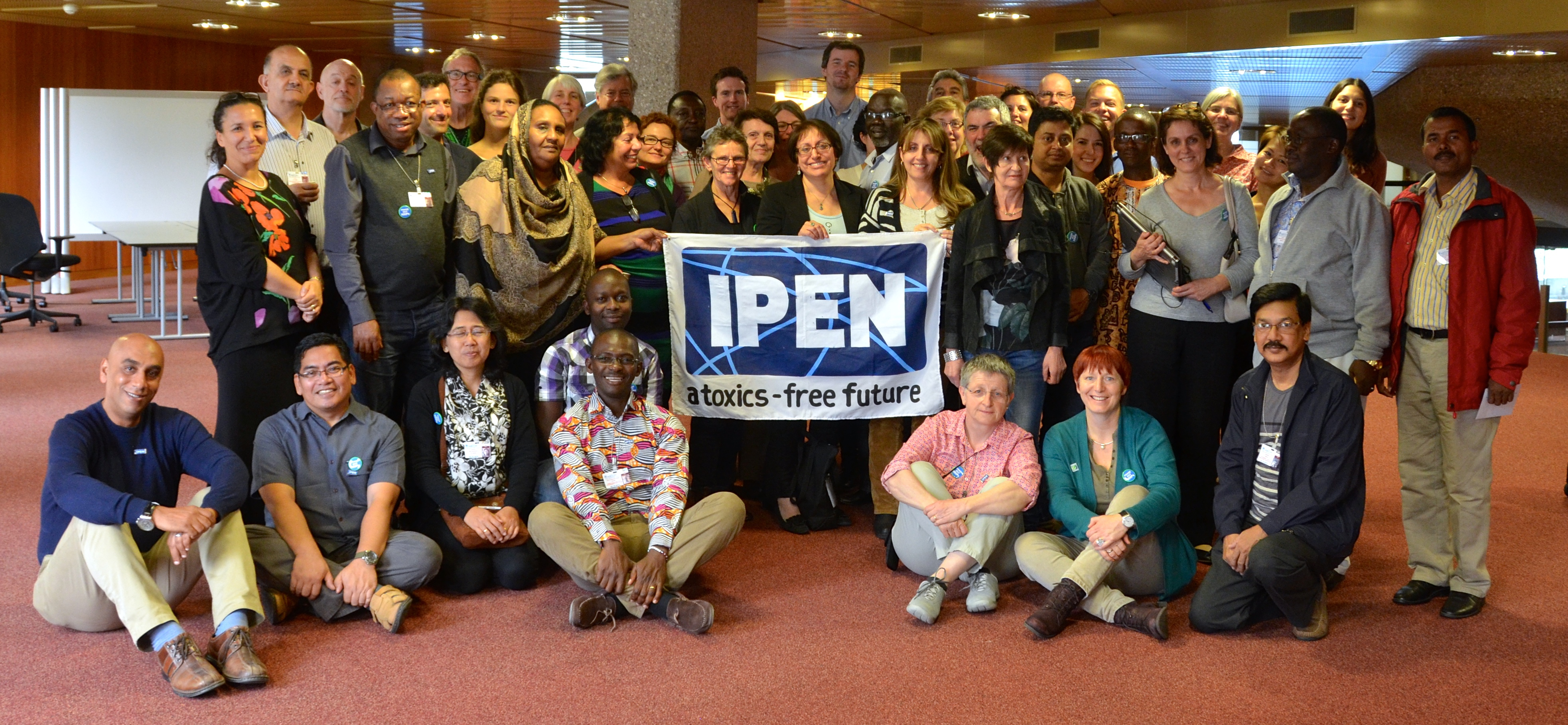HCWH Speaking out for Healthcare at SAICM ICCM4
HCWH Team: Susan Wilburn, Anja Leetz, Ana-Christina Gaeta, Aidan Long
Health Care Without Harm (HCWH) is currently attending the fourth session of the International Conference on Chemicals Management (ICCM4) for the Strategic Approach to International Chemicals Management (SAICM) in Geneva. SAICM is a policy framework that brings together multi-sector stakeholders to address chemical safety. The approach covers agricultural and industrial chemical management throughout their lifecycle; addressing the environmental, economic, social, health, and labour aspects of chemical safety.
ICCM4 is of particular importance because it is the last SAICM meeting before 2020. Stakeholders are expected to make the most effective use of the conference in order to adopt strategic decisions to enable the international community to achieve the 2020 goal of the Johannesburg Plan of Implementation from 2002, as well as the UN Sustainable Development Goals (SDGs) which were agreed upon in New York in September 2015.
HCWH, along with IPEN (The International POPs Elimination Network, working for a toxics-free future) and other NGOs are working together to push for more environmentally sustainable practices to be incorporated into chemicals management policies. As well as the on-going SAICM process, there are also specific ‘Emerging Policy Issues’ (EPIs) being addressed at ICCM4, these are:
- Environmentally Persistent Pharmaceutical Pollutants (EPPPs)
- Chemicals in Products (CiP)
- Nanomaterials
- Highly Hazardous Pesticides (HHPs)
- Lead in Paint
- Electronic Waste
- Endocrine Disrupting Chemicals (EDCs)
- Perfluorinated Compounds (PFCs)

Participating NGOs at the IPEN Preparatory Meeting
HCWH is, as a stakeholder, contributing to ICCM4 to shed light on how these issues are manifest in and affect the healthcare sector. Specifically, HCWH’s work and contribution to ICCM4 focuses on EPPPs, EDCs and Nanomaterials.
Environmentally Persistent Pharmaeutical Pollutants
HCWH is one of the leading advocates for the safe management of pharmaceuticals along their entire life cycle in Europe and around the world. Through discussion and debate with governments and other stakeholders at ICCM4, we are working to encourage countries and agencies to take part in the global efforts to reduce pharmaceutical pollution in environment. We have recently released our position on EPPPs, explaining in greater detail our objectives in relation to EPPPs at ICCM4.
HCWH Europe Executive Director Anja Leetz presenting our position on EPPPs during the plenary meeting
On the second day of ICCM4, Emerging Policy Issues (EPIs) were introduced and discussed at the plenary session, and the governments of Peru and Uruguay, along with the Society of Doctors for the Environment (ISDE), intervened to show their support for pharmaceuticals being included in the SAICM process as an EPI.
Anja Leetz, Executive Director of HCWH Europe, also intervened to highlight the problems associated with pharmaceuticals. She spoke about the prevalence of pharmaceuticals in the environment and the need to take urgent action to develop policies and measures to tackle the growing problem.
"Health Care Without Harm is a global nonprofit organisation working with the health sector in all regions of the world to become more sustainable. Environmentally Persistent Pharmaceutical Pollutants (EPPPs) in the environment have been identified as an emerging environmental concern, with more than 600 pharmaceuticals having been detected in 71 countries (in water, soil, sludge, and organisms)[1]. Due to the nature of the active ingredients in pharmaceuticals, which were designed to develop a response in humans and animals in low concentrations, they often remain unchanged during their consumption and excretion and there is growing concern about pharmaceuticals building up in the environment. This may harm the environment and, in the long-term, human health. Of the pharmaceutical residues found in the environment, antibiotics have some of the most serious consequences, and there are major public health concerns about the presence of antibiotic-resistant pathogens. The international community has recognised the severity of AMR and has called for global action, with the WHO having released a global action plan in May 2015. We support the rational use of medicine as defined by the WHO, take back schemes, and others actions proposed. At the same time we feel more concrete action needs to be taken to address EPPPs." - Intervention by Anja Leetz at the Plenary Session at ICCM4
HCWH welcomes the adoption of EPPPs as a new Emerging Policy Issue and we look forward to working with all stakeholders at ICCM4 and beyond to address the issue.
HCWH also welcomes the position of the EU on EPPPs (as outlined in an plenary intervention at ICCM4), who called for more ambitious action about the issue. During the plenary meeting on the second day, the EU delegate urged the pharmaceutical industry to support the proposed SAICM actions on EPPPs and invited relevant organizations to provide further information and research on this important topic.
Coinciding with our involvement with ICCM4, we have also this week released an infographic illustrating our suggested solutions to minimising the release of pharmaceuticals into the environment along their entire life cycle.
Plenary Meeting
Endocrine Disrupting Chemicals
HCWH are following the debate on EDCs closely at ICCM4. We are calling on all stakeholders present (especially participating countries) to develop more detailed and further-reaching policies to reduce the risk from EDCs, especially in the healthcare sector.
We also support our fellow NGO’s work on EDCs and this week we particularly welcome the release of The Endocrine Society’s Executive Summary of their second Scientific Statement on EDCs, and echo the call for policy development to be based on sound science.
HCWH has published work on EDC in the past. Here you can find our EDC report and leaflet, as well as factsheet on especific EDCs such as phthalate and BPA.
HCWH's Susan Wilburn and Anja Leetz
Nanomaterials
Nanomaterials is another important policy issue we are following at ICCM4. We expect the nanomaterial resolution agreed upon at the conference to integrate the development of “international, technical, and regulatory guidance and training materials for the sound management of manufactured nanomaterials.[2]" HCWH’s work regarding this topic focuses on promoting the environmentally sound management of nanomedicine along its life cycle. In order to assess risk for health workers and patients, they need to be informed when nanomaterials are present in medcial products and where nanomedicine is prescribed. Discussions and debates about nanomaterials are taking place at ICCM4 in the next few days. We have high expectations that ICCM4 will recognise the environmental and health significance of integrating these urgent policy recommendations. Here you can find HCWH's report and factsheet on nanomedicine.
Beyond 2020
Due to decisions taken in 2006, which established that the SAICM process is due to come to an end in 2020, ICCM4 has initiated an intercessional process to begin considering the future of SAICM. It is evident that the work proposed by the SAICM process to tackle chemicals and waste will not be finished by 2020 and it is therefore critical that some process is put in place to continue the important work begun by SAICM.
Much of the discussion at ICCM4 this week has focused on the UN’s Sustainable Development Goals (SDGs) and where SAICM’s work on chemical management fits into these. Developing sustainable and sound chemicals management processes and systems is an essential part of environmental protection and it is important that this is reflected in the actions developed in line with the SDGs.
The work of SAICM is particularly relevant to Target 12.4 of the SDGs, which states:
By 2020, achieve the environmentally sound management of chemicals and all wastes throughout their life cycle, in accordance with agreed international frameworks, and significantly reduce their release to air, water and soil in order to minimize their adverse impacts on human health and the environment.[3]
The role of sustainable chemical management in protecting human and environmental health is a vital to achieving target 12.4, but also important in meeting the other targets. Planning for the future of SAICM, and setting the goal of meeting the SDGs through the processes agreed upon at ICCM4, has made “Beyond 2020” a key topic in ICCM4 discussions.
ICCM4 - Highlights day by day
- Monday 28th of September / Opening day
SAICM OUTCOMES
Environmentally Persistent Pharmaceutical Pollutants (EPPPs)
SAICM ICCM4 negotiations finalised last Friday with a successful agreement on all of the proposed texts. It is a good starting point that EPPPs were adopted as an Emerging Policy Issue in the global SAICM process. As a result, pharmaceutical pollution in the environment is acknowledged as a global challenge that needs addressing.
“We are happy to say that a resolution to pharmaceuticals in the environment got accepted in plenary today. While it is fairly vague and open, it acknowledges for the first time that we have a global problem with pharmaceuticals in the environment. And there is a call to action. We now have to work with all of the stakeholders involved over the coming years to make sure that pharmaceuticals in the environment are addressed in national and international policies.” Anja Leetz, Executive Director, Health Care Without Harm Europe
At ICCM4, we worked with relevant stakeholders, urging them to push for a comprehensive and complete resolution that called for the minimisation of the release of pharmaceuticals into the environment at all stages of their life cycle. Although more specific and further-reaching actions would have been preferable in the final text of the resolution, we are satisfied that the issue has started to be addressed in the international policy arena and there can be little doubt now that pharmaceuticals in the environment are indeed a growing problem that needs to be tackled internationally. The outcomes of ICCM4 are a step forward towards the sustainable management of pharmaceuticals in the environment worldwide.
Endocrine Disrupting Chemicals (EDCs)
The discussions about EDCs at ICCM4 were characterised by dynamic exchanges of visions and opinions between the diverse stakeholders (such as governments, industry, unions, environmental and health organisations). Although a resolution was agreed upon on Friday, there were disagreements between NGOs and industry about some aspects of the final text, such as the difference of opinion on the inclusion of a reference to the UNEP and WHO ‘State of Endocrine Disrupting Chemicals’ report from 2012, with the International Council of Chemicals Associations (the ICCA), CropLife International and the United States Council for International Business objecting to the ‘contentious’ nature of the conclusions of the report. Despite this, however, there was a general agreement amongst most other stakeholders that more research was needed and that exposure to EDCs should be reduced through a number of actions.
Nanomaterials
Regarding Nanomaterials, the agreed final text means that there is now a mandate for a range of activities including awareness raising, capacity building, and information sharing to be conducted by all relevant stakeholders.
The other important issues covered at SAICM ICCM4 included Highly Hazardous Pesticides (HHPs), Chemical Management Beyond 2020, Chemicals in Products (CiP), Hazardous Chemicals in Electronics, and Lead in Paint. For more updates on the outcomes of these issues, visit the IPEN website.
- Ana-Christina Gaeta, Communications Assistant, HCWH Europe

[1] http://www.pharmaceuticals-in-the environment.org/files/en/bereich_4/application/pdf/pharmaceuticals_en_141210_screen.pdf
[2]http://ipen.org/sites/default/files/documents/IPEN%20Quick%20Views%20ICCM4%2021%20Sept%202015%20EN.pdf
